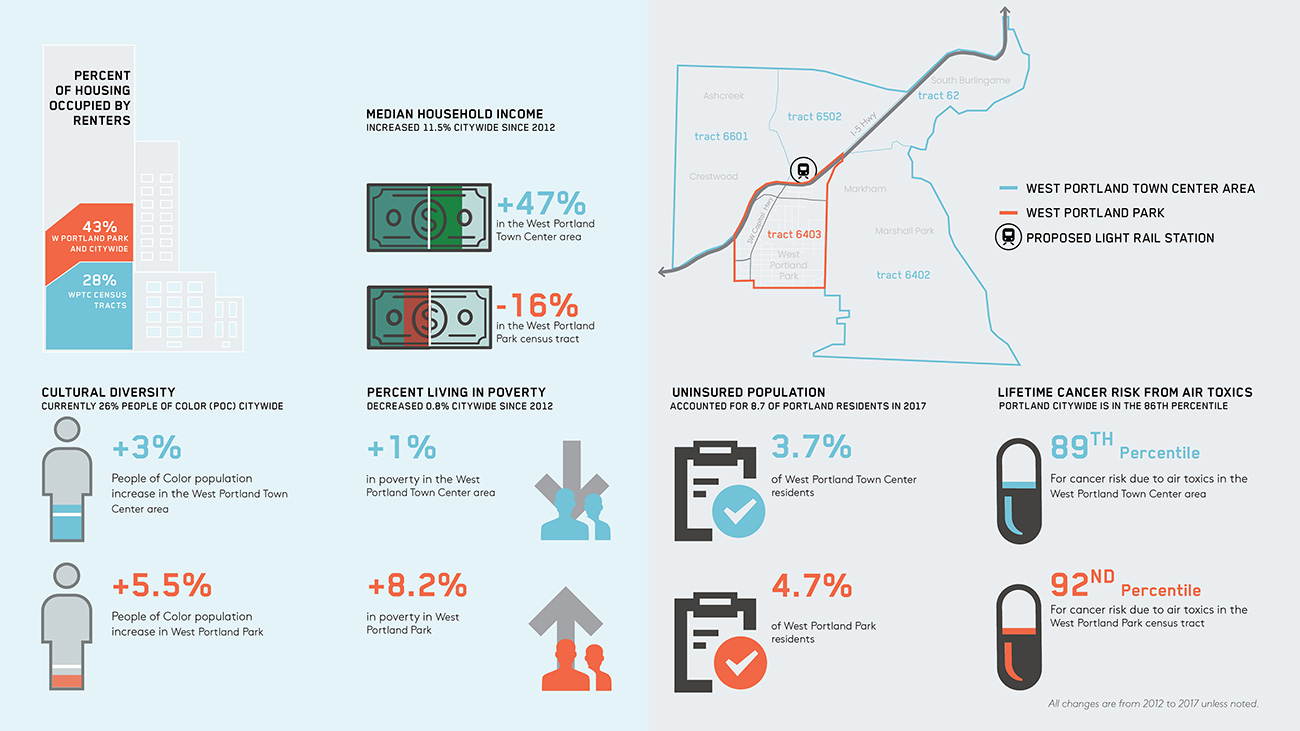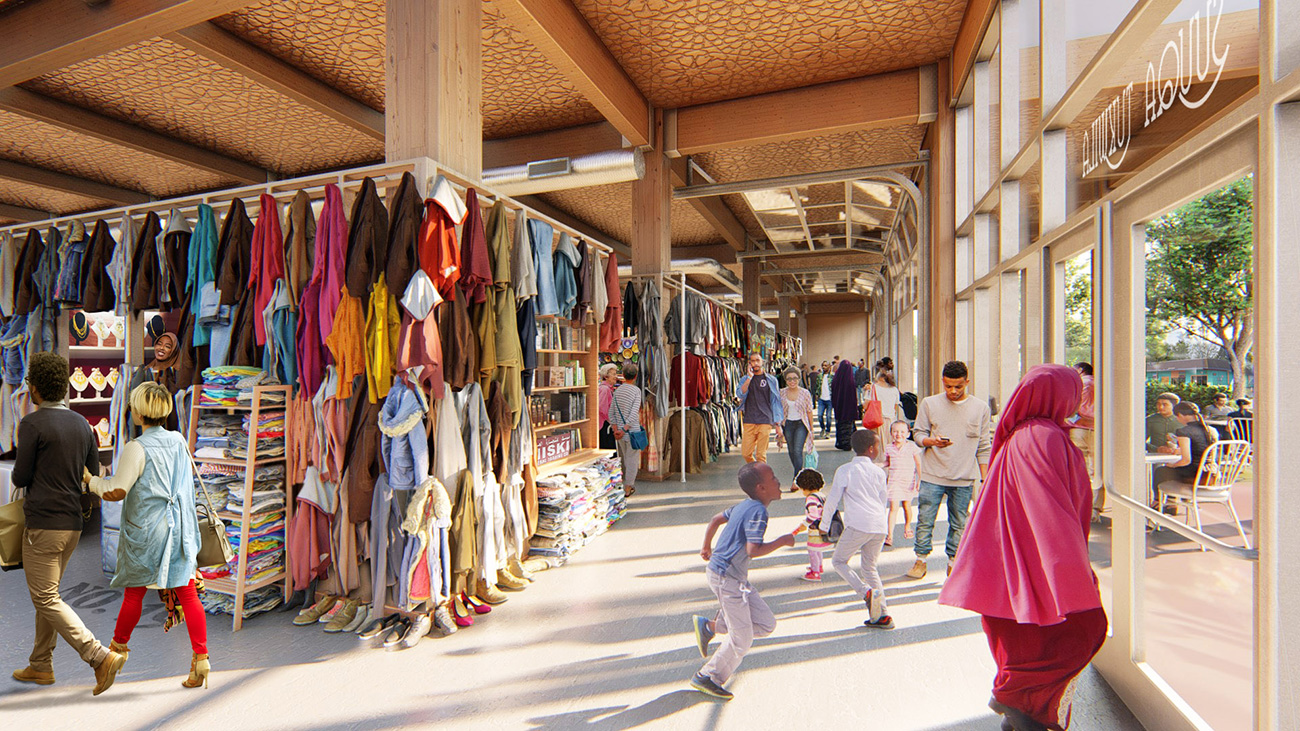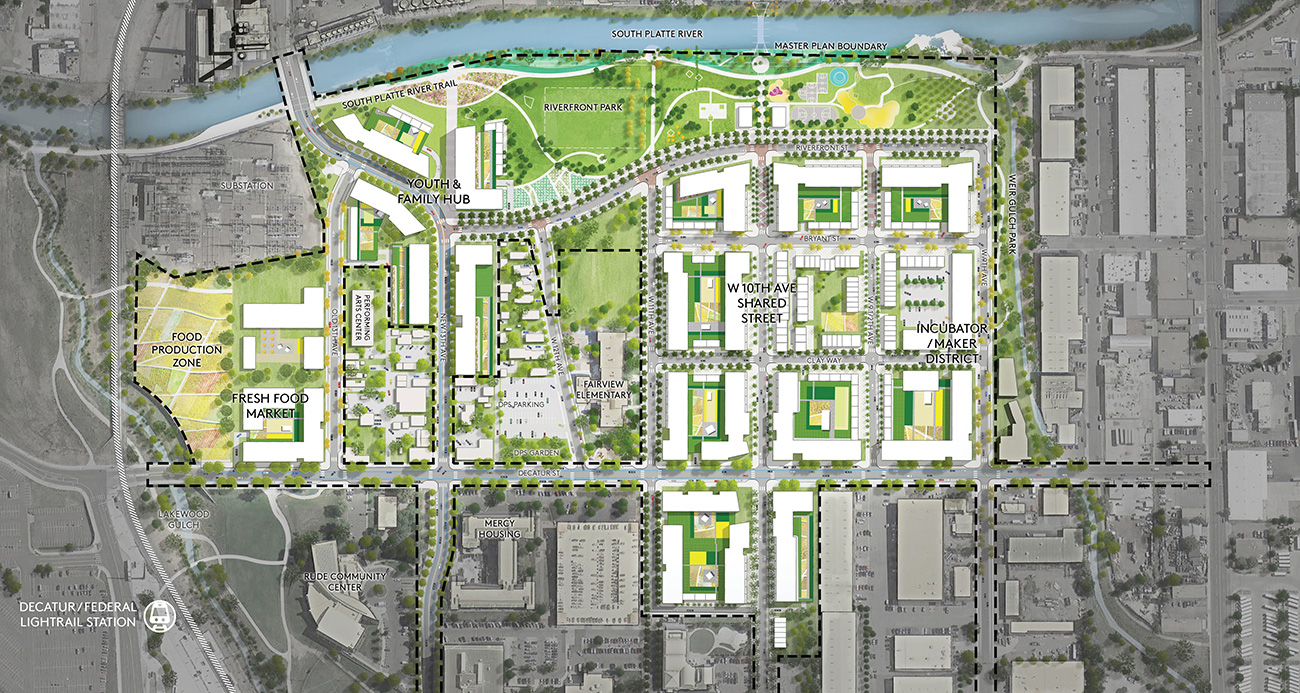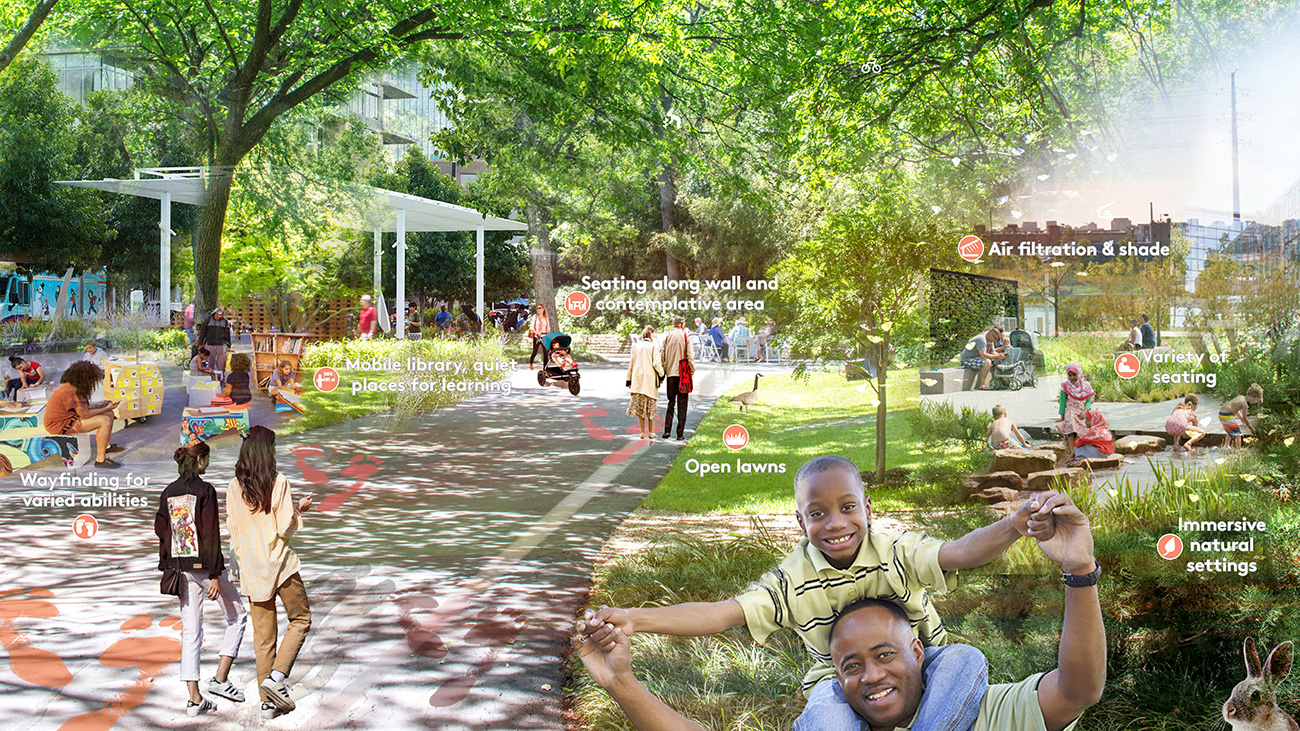Date Posted: 05.18.2021
The past year has tested our resilience—as individuals, as businesses and as a society. Many recognize it is time to change course and build back better through recovery. Leading cities and organizations are looking upstream at systemic causes that have created barriers to healthy housing, clean energy and air, reliable transportation and essential services. They are acting on overwhelming evidence that broad access to opportunity increases economic development, business success and community resilience.
For nearly two decades, Mithun has designed healthy places across North America, through human-scaled urban design, transit-oriented development, connections with nature, and community revitalization in cities like Denver, Portland, Phoenix and San Francisco. We have made remarkable progress shifting development patterns to more connected, walkable places for people to live, work, learn and play. Yet, today, communities are weathering our health, climate and housing crises much differently, and the inequities are growing.
Over the course of 2020, we collaborated with innovative organizations to rapidly deploy emerging methods centered around health equity and environmental justice. As designers, we sought out new forms of thinking and problem solving that might address institutionalized barriers, guided by our colleagues’ call to action in Confronting Power and Privilege for Inclusive, Equitable and Healthy Communities. With an unwavering belief in design’s capacity to connect people to each other, we dug into the root causes and our own varied dimensions of privilege to test specific practices and shift our work toward more resilient, inclusive communities.
INCLUSIVE ECONOMY AND ANTI-DISPLACEMENT IN WEST PORTLAND
The East African and Arab Muslim community have established deep roots in the West Portland Town Center. This part of Portland was annexed in mid-twentieth century and while a high opportunity area with community amenities, it has a suburban development pattern lacking sidewalks and divided by highways and major arterials. It is currently the most racially and economically diverse area of southwest Portland and is expecting new regional transit connections as part of the planned Trimet Southwest Corridor light rail extension. Mithun supported the City of Portland’s Bureau of Planning and Sustainability on the West Portland Area Plan.
Resourcing Communities
The City devoted one-third of the planning budget to community-based organizations to engage renters and immigrants and understand their lived experience. As the planning and engagement kicked off, we conducted a health equity assessment to better understand root causes within the environments where people are born, live, learn, work, play and age that affect a wide range of health outcomes. Combining this quantitative analysis in the health equity assessment with prioritized feedback from community engagement, we found the most pressing barriers to health for everyone in the built environment were traffic safety, infrastructure as a divider, air pollution and noise.
Lived Experience Ranges Dramatically
We also dove deeper to better understand how health risks are experienced differently. A big factor is where you live, which is shaped by land use, lending and economic systems often rooted in exclusionary practices. The City published a report on the History of Racist Planning in Portland, and Multnomah County is among many who have declared racism a public health emergency. Project research studied the specific relationships between inclusion and health, and scanned health evidence to better understand how racism can trickle down to specifically increase risk of cardiovascular disease, chronic stress and diabetes. Our research found disparities for the West Portland Town Center compared to the rest of the city, including life expectancy, insurance, poverty, housing cost burden and cancer risk.
Social connections are a crucial opportunity to improve health for the Black, immigrant and refugee community in Southwest Portland. Our built environment and socio-economic policies play an active role shaping social inclusion—whether supportive or not. Our research found that today’s context, shaped largely around auto infrastructure, works against forming social connections and networks.

The health equity assessment of West Portland Town Center found a significant disparity in health and wealth outcomes for People of Color, and multiple negative impacts of the highways that divide the community.
Transit and Cultural Hubs
During the planning process, the immigrant Muslim community united around their idea of a multi-cultural hub as part of a redeveloped Barbur Transit Center. They saw the Hub as an opportunity to serve the existing community around the mosque and better connect them to neighborhoods across the highway. Envisioned as a multi-cultural community center, the Hub could incorporate gathering space for cross-cultural events, human services, affordable housing and affordable commercial space for BIPOC and immigrant-owned businesses like halal markets. With its location at the new multi-modal transit center, there is a fantastic opportunity for access and to highlight culture through art and design. Similar ‘hub’ models that include cross-sector partnerships have been built by institutions like the North Seattle Community College’s Opportunity Center and are in development by non-profits and land trusts like Forterra’s Wadajir Market and Residences in Tukwila, Washington.

A rendering of the market at the ground level of Wadajir Market and Residences pictures flexible space for small businesses and the community to come together.
A WELCOMING COMMUNITY IN KIRKLAND
In the suburban community of Kirkland, which experienced most of its growth from the 1970’s onward, transportation infrastructure has always been a part of the growth story. With plans for a once-in-a-generation regional transit investment including a new Bus Rapid Transit (BRT) station, Mithun is leading the City of Kirkland’s NE 85th Station Area Plan to set a vision for an inclusive, sustainable, transit-oriented community, and will consider changes to policies and zoning to create the most value and quality of life for the city. Over the past several years, the City has made a commitment to inclusion through the Welcoming Kirkland Initiative that also inspired this planning process.
The Toll of Commuting on Everyone’s Health
Kirkland offers a remarkable quality of life, with high-performing schools, a life expectancy higher than the King County average and low crime rates. At the same time, an imbalance between housing and jobs comes from housing prices one hundred and fifty percent of the county average and minimal rental housing available, paired with nearly fifty percent of jobs in the station area below the median household income. As a result, the vast majority (89%) of residents leave daily for jobs outside the city and nearly all employees commute into Kirkland. People have less time to spend with family and support their own well-being, and physical challenges related to an auto-dominated environment with poor infrastructure for walking and biking adds to inequities. Air pollution is exacerbated, increasing risks of cardiovascular and respiratory disease, and possibly contributing to COVID-19 transmission.

A health equity assessment and resilience mapping in the NE 85th Station Area revealed the compounding impacts of highway infrastructure that divides the neighborhoods and makes it harder for people to connect to each other and resources.
The Need to Connect with Community
The predominant suburban development pattern and lack of community gathering places reduces resident and employee opportunities for safe physical activity and access to grocery and health facilities, and ultimately results in a lack of social cohesion. Extremely limited daily opportunities for people to interact can present significant risks in case of emergency, because neighbors often become the de facto ‘first responders’ in crisis. During the Chicago 1995 heatwave, a community with an intact public realm and cohesion had one-tenth the death rate than a neighboring, auto-oriented community with nearly identical demographics.
Shifting the Momentum of Our Institutions
The City of Kirkland, like the planning field at large, has focused on creating pedestrian-oriented, mixed-use and commercial districts that highlight natural resources and provide gathering spaces and amenities. However, since the project equity assessment revealed that housing costs price out many people and limit access to these opportunities for healthy living, the team has shifted towards a process that centers equity as part of the project vision and values. We are using tools like the King County Equity Impact Review to understand equity in the planning process and facilitate the conversation with the community. An important lesson is how current planning and environmental regulations favor existing communities and landowners. This has the effect of reinforcing the status quo—despite the environmental, health, and economic challenge of today’s context. By starting early, health equity assessments have proven an important tool to frame the public discourse and influence decision-makers like the Planning Commission and Council Members.
FOOD AND HEALING IN THE SUN VALLEY ECODISTRICT
The Sun Valley neighborhood of Denver is currently undergoing redevelopment as part of the Denver Housing Authority’s (DHA) Choice Neighborhoods Transformation—a catalyst project in this 380-acre district bound by the Sports Authority Field at Mile High, the South Platte River, Federal Boulevard and an industrial area to the south. Half of its residents are under 18 years old, many are immigrants, and this area has the highest concentration of poverty in the state. DHA has a long-term institutional commitment to resident health and wellbeing, spurred through collaboration with Mithun more than a decade ago with the Mariposa Redevelopment and Healthy Living Initiative. Through this experience, we understand the importance of nurturing long-term relationships and collective impact. It takes a village—all stakeholders throughout the planning, design, and project delivery process—to realize outcomes.

The Sun Valley Healthy Choice Neighborhoods Plan reflects a community- driven model focused on building trust with the community through lasting relationships, collaboration, and ongoing engagement. It is guiding the transformation of this isolated area impacted by redlining, highway infrastructure and proximity to industrial uses, into a next-generation community centered around families, food, and open space along the South Platte River.
Building Trust, Centering Healing
Design can be a powerful tool to connect people. A community-led approach in Mithun’s district planning helped build trust and included two unique ways of working directly with community members. First, resident ‘Community Connectors’ were hired to liaise with specific cultural communities (East African, Latinx and Vietnamese), work directly with the design team and encourage resident participation. Second, we hired a local resident and health ecosystem consultant, Rodolfo Rodríguez, to conduct on-the-ground assessments including a building façade activation study, a public life survey together with Community Connectors and a cultural health survey and interview of residents. We disaggregated health data by race, age and immigration status.
Combined, these sources indicated that the lived experience of many residents includes multiple traumas—past and current. Thirty percent of residents reported experiencing discrimination in the neighborhood, the crime rate is three times the city average, and mental and emotional health was a top concern and health issues for residents. Yet, despite these challenges, our on-the-ground surveys and interviews found strong social cohesion within the community. The Health Action Plan was designed around supporting existing social cohesion as a critical asset. Throughout the district, design and program strategies are aimed to help address trauma and promote mental health, from biophilic design and safe, restorative spaces, to promoting intergenerational spaces, limiting relocation and partnering on domestic violence awareness programs. The team is examining Crime Prevention Through Environmental Design (CPTED) practices in light of concerns around surveillance and emerging design justice guidance. Mithun is actively supporting project design teams to explore how Enterprise Green Communities’ new Healing Centered Design Criteria might apply to multi-family residential interior and exterior environments.
Shared Passion, Collective Impact
The “Grow Sun Valley” campaign for healthy food is a remarkable example of how a health strategy can be realized throughout many aspects of a community. What started early on as a resident priority and shared passion, grew into a series of projects and programs that are intentional about using ‘growing’ as a wealth-building strategy. Food production is a key element of the plan, which includes a Grow Community Garden, the Decatur Fresh market grocery and a micro-business incubator—all designed to be integral to the community rather than stand-alone facilities. Food distribution and shared production facilities will support cultural food preparation practices. Along the riverfront park, a micro-restaurant incubator will support residents and start-up chefs locating to Sun Valley to start their own businesses. They are stewarded across real estate, resident services and property management departments of DHA with partnerships with local Sun Valley organizations, like EarthLinks and the Sun Valley Youth Center.
Our urban design team worked closely with residents, community partners and technical advisors to develop this array of evidence-based projects and programs. Cross-sector leaders of foundations, local government, developers, hospitals and health plans decided to invest in preventive medicine through community development. For communities to gain momentum towards these ambitious outcomes, tools like a Health Action Plan are proven to invite others in by openly sharing goals, a vision and even challenges.

The Sun Valley Healthy Living Design Guidelines highlight ample evidence-based opportunities to promote inclusion, physical and mental health in public realm design.
Leading organizations see health equity as more than a social goal—they recognize it as a strategic imperative. The proven tools and emerging practices we deployed have broad application across sectors, from conceptual and strategic planning down to project design and implementation. Through our integrated design process and project outcomes, we aim to build a community of practice centering health equity and enhanced capacity for resilience.
Explore more of Mithun’s work with districts, neighborhoods and campuses.